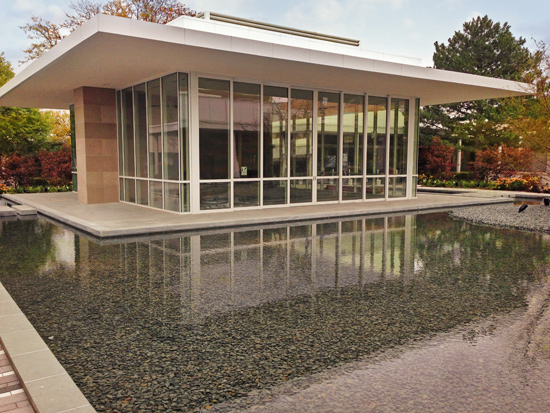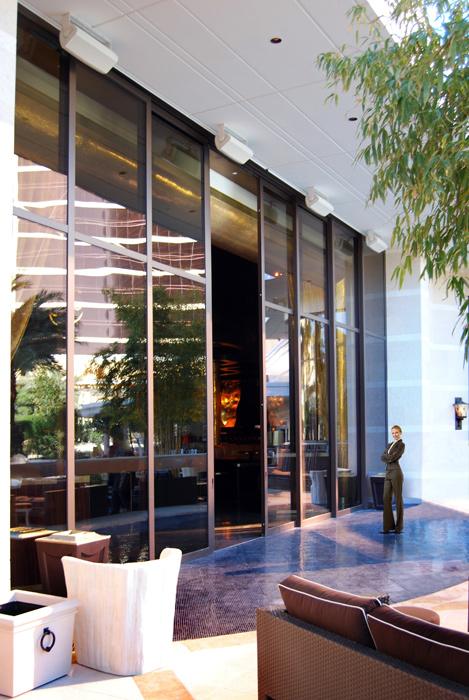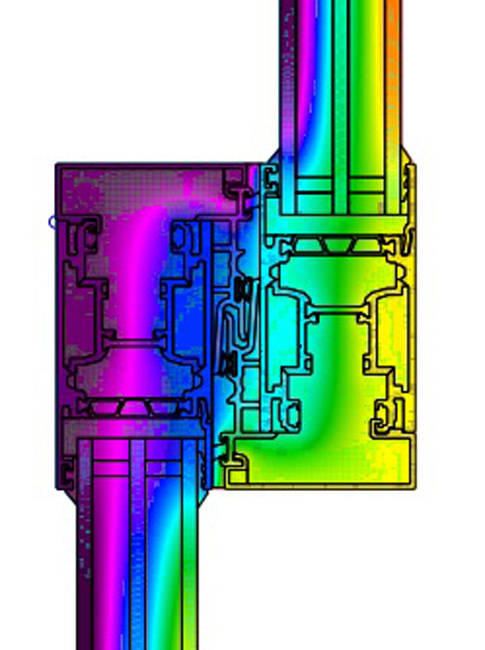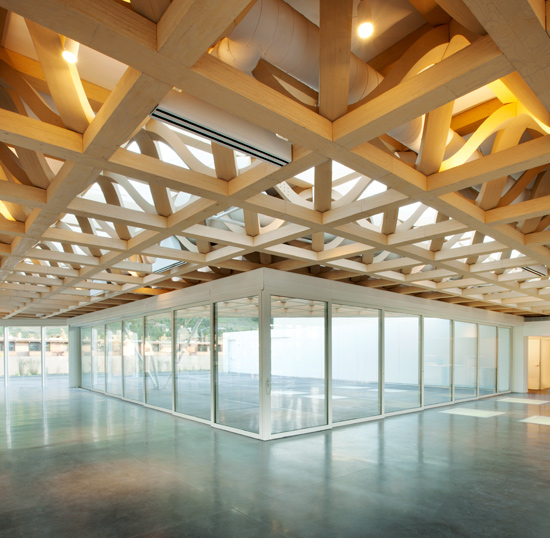Panoramic Glass Door Systems in Green Buildings
Thermal performance can be achieved through successful building design using large openings
![]() Continuing Education
Continuing Education
Use the following learning objectives to focus your study while reading this month’s Continuing Education article.
Learning Objectives - After reading this article, you will be able to:
- Identify the problems with heat loss and heat gain through large openings and the solutions provided by thermally broken products.
- Describe the components of thermally broken products that contribute to energy efficiency.
- Define the benefits of providing greater access to daylight, fresh air and occupant comfort by designing a high-performance building.
- Discuss the triple bottom line of purchasing thermally broken products and the return on investment for large high-performance openings.
Living in Northern Illinois in the winter and the summer can be a challenge. The lack of daylight, snow, ice and bitter cold and conversely, the hot, humid summers increase the amount of hours spent inside. On average, most Americans spend up to 90 percent of their time indoors.i Studies show that humans may be genetically programmed to the diurnal cycle and require more daylight and the sensory variety of the natural world. Architects are responding to evidence place design with new open concepts that provide direct access to the outdoors.
In the newly renovated Oakbrook Center in Oakbrook, Illinois, Omniplan Architects created a new public space in the heart of the mall. The glass pavilion opens up to a large reflecting pool, gardens and a sheltered courtyard during the moderate seasons of the year. This pavilion includes a 32-foot-wide by 14-foot-tall, bi-parting, lift and slide door system surrounded by a large glass curtain wall. During wet, hot or bitter cold seasons, the public can comfortably sit by these large glass walls. In better weather, seating is provided next to the pool and in the gardens for both formal and informal gatherings. This massive door opening would not be able to meet current ASHRAE 90.1 codes for the thermal insulation if it were not for the integral components of its thermally broken aluminum frames and highly insulated glass. This pavilion is an example of new opportunities for designers of high-performance buildings to meet sustainable design goals for energy efficiency and the optimization of human comfort.
Architects can have a difficult design challenge when meeting both the requirements for stringent energy codes, aesthetics and human comfort. Too often, the best seat with the panoramic view of nature by the large glass window is either too cold or too hot. ANSI/ASHRAE Standard 55-2010ii defines the range of indoor thermal environmental conditions acceptable to a majority of occupants. These include strict regulations on wall to window ratios and thermal behavior of all wall systems. Advancements in aluminum frames, glass and operable doors now accommodate an ever-increasing variety of design alternatives for large openings that meet sustainable building criteria. Architects can design openings that span over 80 feet wide and range from 10 – 20 feet high. Custom door opening systems can be specified with a range of colors, finishes, glazing, sizes and materials.

Photo courtesy of Panda Windows & Doors
The renovation of the Oakbrook, Illinois, shopping center includes a 32-foot-wide by 14-foot-tall bi-parting, thermally broken lift and slide door system that provides direct access to the mall's courtyard.
High-performance glass doors can provide many benefits for sustainable buildings. They can meet thermal comfort values measurable in ASHRAE standards while providing views to nature and access to daylight. Architects have more flexibility due to the advancement in frames that prevent heat transfer with thermal breaks and glass specified with high insulation values.
Heat transfer through framing in glass walls is called thermal bridging. Thermal bridging is created when materials that are poor thermal insulators come into contact, allowing heat (or cold) to flow through the path of least thermal resistance created. Thermal break insulation is designed to prevent resistance to heat flow by using a material that separates two highly conductive metals such as aluminum. New thermal break products are part of the movement to design high-performance glass openings that can meet sustainable building standards. Ximena Rojas, marketing director at Panda Windows & Doors, says, “Using a thermally broken window or door on a project can assist in enhancing the healthy living environment and sustainability of a project.” She continues, “Thermally broken products can have many environmental benefits; they help improve a building’s energy performance, offer a higher degree of acoustic insulation and have longer service life due to their resistance to the elements.”
The window-to-wall ratio is the ratio of window or opening (glazing) to wall area. It is expressed as a percent. If the window-to-wall ratio is greater than 40 percent, ASHRAE 90.1 provides guidance as to the prescriptive measures necessary to meet the International Building Code. Meeting the code requires designers control both the amount of light in a building as well as the amount of heat loss or gain. The advantages of using integrated building envelopes with attention to the performance of all components mean that the architect can increase the size of glass wall opening systems that also bring high performance benefits.

Photo courtesy of Panda Windows & Doors
The XS Nightclub at the Encore Hotel in Las Vegas, Nevada, has a 41-foot-wide by 20-foot-high opening. The eight panels of the lift and slide doors part in the center of this opening and pocket on each side to open up the club to a large cabana-style pool area.

Source: U.S. Department of Energy

Image courtesy of Panda Windows & Doors
An illustration of the properties of heat flow through an aluminum thermally broken frame.
Design for Climate Zones
Advances in glass opening frame systems have created new products that provide structural stability and flexible design that allow larger operable openings. These systems have higher insulation values and provide thermal barriers to prevent thermal bridging.
Thermal barriers or thermal breaks are included in frames to provide resistance to heat flow. An aluminum thermally broken frame minimizes heat loss from the inside of a building, as well as heat gain from the outside. In the illustration of the high-performance frame shown in this article, the central polyamide iso-bar core material with glass fibers acts as a barrier for heat flow from a warm interior to a cold exterior in winter and vice-versa in summer. The illustration demonstrates how thermally broken frames prevent cold air bridging, restricting airflow from either direction as it "pools" in the middle of the frame. This type of frame construction creates a high level of thermal resistance and utilizes the added benefits of the properties of aluminum such as durability, strength, stability and corrosion resistance.
When designing the components for large openings, the architect will select the correct combination of the orientation of the opening, the glass and frame type necessary to meet the specific project climate zone. There are many advantages to selecting all of the components, the entire window and door package for a large operable door opening system from one manufacturer. These include the following benefits:
• Structural stability
• Superior energy efficiency
• Ease of installation
• Integrated components with warranties that are “all-inclusive” including glass, frames and opening mechanisms
• Factory construction that reduces on-site errors.
Comparing systems requires a true life-cycle analysis that includes not just the initial material costs, but the added benefits of continued energy efficiency, durability and ease of maintenance. One of the biggest mistakes that design teams make is the selection of a non-thermally broken system which becomes a problem in the long run because it is not an appropriate system for the climate in which the project is located.
The following case study is an example of how new technology for massive openings can support the design visions of the 2014 Laureate for the Pritzker Prize, architect Shigeru Ban.
Meeting Sustainable Design Goals With Large Glass Door Openings
Architects can meet even more sustainable design goals by using high-performance glass door systems. As seen in the Aspen Art Museum, the architects were able to meet energy codes with highly insulated glass and a thermally broken frame. The glass opening was structurally stable and will be easy to maintain due to the aluminum frame. The specified materials provide durability and longevity for the large glass openings that are one of the signature elements of the museum.

Photo courtesy of Panda Windows & Doors
Glazing systems can include double or triple pane glass, along with transparent coatings with insulating gas provided between the panes.
Thermal Performance and Other Sustainable Components
Architects should consider all components of a sustainable glass opening in order to maximize performance. The goal is to increase energy efficiency by selecting components that reduce heat loss or heat gain. By using less energy, architects also reduce the carbon footprint of the building. The thermal components of a glass door opening system include the following:
• Glass: Glazing should be selected according to climate and building orientation. Glazing systems can include double or triple pane glass, along with transparent coatings with insulating gas provided between the panes.
Glazing systems that are supplied by a single manufacturer can provide lower heat loss and less air leakage. Windows and doors have a major influence in heating and cooling processes. This is all measured through a coefficient called “Solar Heat Gain Coefficient” (SHGC) which reports, within a scale from 1 to 0, how well windows and doors block heat from the sun. The lower the SHGC, the less solar heat is transmitted into the building. U-factor of a window or door assembly is equivalent to the rating of heat loss, so the lower the U-factor, the greater a window’s resistance to heat flow. A high-performance window or door system should have a U-factor of 0.30 or lower.
• Thermal break technology: There are many ways to provide thermal separations. For example, an aluminum frame profile can be separated in order to reduce thermal conductivity. To isolate heat, some companies remove strips of the aluminum panels' extrusion and fill those areas with a low-cost option such as plastic. In comparison, high-performance frames are constructed as two separate extrusions and then are crimped together using insulation as the joining material. This means that there are no aluminum connections. Manufacturers of these windows and doors are using a polyamide iso-bar, with integrated glass fibers to optimize the strength of the connections. Iso-bar insulation is a polyester fiber that is resistant to condensation and has high thermal resistance. Some iso-bar insulation is made of recycled PET bottles and can be recycled.
• Seals: The seals at the edges of all framed openings need to be weather-tight. For example, in a lift and slide door one mechanism uses the weight of the panel along with the lever to compress the seals at the top and bottom of a door opening when in the “down” position. The seals of these large openings are engineered to meet hurricane and impact testing standards.
Other components that contribute to sustainability of high-performance windows and door openings such as durability include:
• Frames and extrusions: Window and door systems that are constructed of aluminum extrusions can provide greater stability and strength for larger openings. The advantages of aluminum for large framed openings are discussed later in this article. Aluminum frames can be selected with very narrow profiles, further optimizing the views to the outdoors. These frames can also be specified with wood cladding on the interior to add warmth and character to the interior finish. Aluminum frames have very long life cycles and are easy to maintain.
• Recessed tracks: Recessed U-channel track options are offered for an ADA-compliant and seamless transition from the interior to exterior spaces. In new lift and slide doors, recessed tracks can be specified either with or without a drain channel. In one system, the only visible track is a 3/16-inch rail protruding from the finished floor.
• Multiple configurations: Architects have many options for different types of glass openings. They can expand the interior into the exterior with openings that can lift and slide, fold and pivot. These are just some of the variations that allow the architect to design numerous types of flexible large openings:
• Folding door systems can maximize an opening without having to include pocket door panels. A folding door system can stack and either swing-and-stack to the interior or the exterior. Folding doors are used along a single-track system and are made up of multiple panels (up to as many as 10 in one direction). The weight of the panels is carried along the header that allows for ease of operation, even with large groups of panels.
• New lift and slide doors, even those that weigh more than 200 pounds, can be easily moved with the push of a finger. As seen in the case study for the Aspen Museum, these door systems can be used to span very large openings. They can be specified with numerous track options including the ADA recessed track as mentioned earlier. Lift and slide openings are a type of sliding wall with superior performance. When the systems are closed, they have a very tight seal. Heavyweight hardware allows the system panels to be oversized and still run smoothly.
• Multi-slide panels provide great flexibility for many configurations. The number of panels used varies based on the configuration and number of vertical sight lines desired (usually between 3 and 10 panels). The panels may all stack on one end behind each other to create a total opening of all but one panel’s width as a viewing obstruction. In order to eliminate viewing obstructions, all panels may be pocketed to one or both sides of an opening. Stacking systems may also bi-part and stack on both sides. Multi-slide systems operate on a bottom wheel set or series of sets that allow the panels to easily glide along a track system.
• Horizontal sliding wall systems (HSW) are used in both interior and exterior applications including those that require unique solutions for the design of the stacking area. These partitions can be flexibly designed to suit different structural conditions and design concepts. These systems can be parked in a range of different positions. The designer can align the stack of panels so they are parallel, perpendicular or at an angle to the opening. They can also be readily visible for an effect or hidden behind columns, walls, etc. Individual panels in the configuration can perform different functions ranging from simple sliding panels to integrated pivot or swing doors.
To assure quality performance, design professionals can request documentation of third-party testing and certifications. These tests may include information on the quality of the opening, seals and hardware against air leakage, resistance to condensation and thermal performance. The National Fenestration Rating Council is a non-profit organization that provides uniform, independent rating and labeling systems for the energy performance of all window, door and attachment systems. To achieve these certifications, manufacturers are required to document the testing of their products. These often include actual air pressure and thermal simulations by a third-party testing agency. Reports from the National Fenestration Rating Council will provide valuable information on the performance of doors, tracks, mechanisms and windows.

Photo courtesy of Panda Windows & Doors
Design professionals should require certifications of thermal and or air pressure simulations when selecting a high-performance glass opening.
The large doors and glass opening at the Oakbrook Center Pavilions, is an example of how to meet stringent energy codes with larger openings. According to Project Architect Mark Schantz, AIA, of Omniplan Architects, the engineers provided energy models to the Oakbrook building department working closely with them for approvals. The engineers specified a high-performance glass system with a winter U-value of 0.28 and a summer U-value of 0.26. The glass opening with a shading coefficient of 0.27 was protected from the summer sun with a large 10-foot overhang. The original 1962 shopping center was the largest outdoor shopping center in the country. With the addition of the glass pavilions, the architects have renewed the spirit of place with this indoor/outdoor café that allows the public to experience the gardens, fountains and the outdoors, even in the winter.

Photo courtesy of Panda Windows & Doors
This recessed u-channel track provides ADA compliance and a seamless transition from the interior to exterior spaces.
Sustainability and Aluminum Framing
New designs using large glass openings were primarily made possible by the advancement in the use of extruded aluminum as a structural material. Aluminum is an alloy that provides twice-as-much strength per weight as steel. Aluminum glass frames are extruded components. These components can be manufactured to meet any profile, using the least amount of material necessary to provide the maximum strength over the distance of the frame required. This material offers plenty of design flexibility due to being ductile and easily formable. This allows designers to customize openings to meet aesthetic requirements without large up-charges.
An example of the expansive use of aluminum frames is the large glass opening installed in the luxurious 65,000-square-foot Drais Beachclub Nightclub located in Las Vegas, Nevada on the rooftop of the Cromwell Hotel. This lift and slide opening is 60 feet long by 21 feet high with eight panel openings. The recessed track system provides a seamless barefoot pathway from inside to out for patrons of both the pool and the bar. This colossal opening was designed to open the interior space of the nightclub into the exterior pool area that provides exciting views of the Las Vegas strip below.

Photo courtesy of Panda Windows & Doors
Designed by Leo Daly Architect, the 65,000-square-foot Drais Beachclub Nightclub is located in Las Vegas, Nevada on the rooftop of the Cromwell Hotel. This lift and slide opening is 60 feet long by 21 feet high with eight panel openings.
In addition to providing great strength for large openings, aluminum frames have the following advantages. Aluminum frames are corrosion resistant which contributes to the longevity of the glass opening and easy maintenance. Aluminum is 100 percent recyclable and continues to have high scrap values. Aluminum is a material that can be repeatedly recycled, retaining the same material physical properties. Aluminum can be up-cycled into materials of the same or greater value as a structural member.

Photo by Tim Lee Photography, courtesy of Panda Windows & Doors
The wide 62-inch panels in this Jupiter, Florida home ensures maximum views of the ocean with a minimum of obstructions.
Sustainability and Large Openings that Contribute to Well-Being
Studies of building performance and human comfort indicate that humans need exposure to daylight, fresh air and nature in order to maximize performance. Numerous rating systems, including the USGBC LEED® program, credit building designs that meet a variety of criteria for daylight and natural ventilation. There are many sustainable design advantages to providing large, flexible openings in buildings. These include the following.
• Access to Daylight: Large glass panels allow a lot of natural daylight into buildings during the day. Large ground-to-ceiling panels remove the barriers from inside to outside. By using more glass, the indoor comfort of these daylight zones is increased. Studies have shown improvements in test scores, absenteeism and healing when buildings provide greater daylight access.
• Efficient Lighting: Daylight perimeter zones reduce electrical loads in a building. Natural daylight can provide adequate task lighting when properly shaded from glare. An integrated lighting design for a high-performance building can include lighting sensors paired with large openings to reduce the electrical loads.
• Space Maximization: Large glass doors that can open into new spaces create new places. They optimize the use of interior and exterior spaces. In addition large doors provide the following benefits:
o Fresh air: With a large glass door, space becomes big enough to let in large surges of air providing cooling and improved air quality. In some climates, large openings can improve energy efficiency by reducing the need for air conditioning in the summer months.
o Maximized views: When a large glass door is used, the natural surrounding becomes a part of the property. The view of the outdoors will be available 365 days a year.
o Increased occupancy: Restaurants can increase their seating capacity in the summer months while keeping the weather out in the colder seasons.

Photo courtesy of Panda Windows & Doors
The Chayo restaurant at the Linq Hotel and Casino in Las Vegas increased their seating capacity with large glass door openings in the summer months while keeping the weather out in colder months.
The Triple Bottom Line and Large, Energy-Efficient Openings
According to the Building Managers and Owners Association (BOMA), a high-performance building uses integrated building processes that enhance performance. A high-performance building operates at a higher level with lower costs. A sustainably designed high-performance building also responds to the triple bottom line of people, planet and profits. These buildings can meet the challenges of environmental design that also provides a good return on investment by using smart design and technology that increases the durability of the building and provides energy savings. High-performance sustainable buildings require an integrated design process that requires components that are durable, easy to maintain and meet energy codes. These buildings deliver a good return on investment. They provide life-cycle benefits measured both numerically as in energy savings as well as psychologically as in client, staff and customer satisfaction.
There are many advantages to providing large glass openings to the outdoors but until lately, the disadvantages far outweighed the benefits. New thermally broken high-performance glass openings have provided more opportunities for sustainable design. These openings can have doors that pivot, slide and disappear to create new places that engage the public. These systems can deliver enhanced building energy performance and increase human comfort.
In 1949, Philip Johnson designed and built his glass house as a statement about nature and existence. In this building, nature flows into the structure to create an illusion of shelter without walls. Since the construction of that seminal Modernist building, many architects have been striving to achieve this similar aesthetic without sacrificing comfort or creating buildings with large energy footprints. With older glass wall systems, sitting next to the window in the winter could mean adding an extra layer of clothing. In the summer, the glare and heat transfer also made this seating equally uncomfortable.
Fortunately, the latest thermal break technology has enabled designers to have more design flexibility for large door openings. They can meet many design criteria for green building credit rating programs such as the United States Green Building LEED® program, Green Globes, BREEAM, the Living Building Challenge or the new Passive House Standard by optimizing access to fresh air, daylight and views of nature. Large glass openings specified with high-performance materials support sustainable design goals by providing increased energy efficiency while optimizing comfort. Innovations in streetscape design and neighborhood planning are part of the new urban placemaking movement and the ability to open up facades to the sidewalk with operable walls and windows creates more lively downtowns.
Architect Celeste Allen Novak, FAIA, LEED AP (www.celesteallennovakarchitect.com) specializes in sustainable design and planning in Ann Arbor, Michigan. She is the author of "Designing Rainwater Harvesting Systems: Integrating Rainwater Into Building Systems."
Endnotes
i U.S. Environmental Protection Agency. 1989. Report to Congress on indoor air quality: Volume 2. EPA/400/1-89/001C. Washington, DC.
ii https://www.ashrae.org/resources--publications/bookstore/standard-55. December 14, 2014
iii Guide to Determining Climate Regions by County. http://apps1.eere.energy.gov/buildings/publications/pdfs/building_america/ba_climateguide
_7_1.pdf December 14, 2014.
v http://www.efficientwindows.org/
vi http://www.efficientwindows.org/
vii http://www.energystar.gov/index.cfm?c=windows_doors.pr_ind_tested
 |
Designed and manufactured in Las Vegas, Panda’s glass wall systems are backed by a quarter of a century of architectural design and engineering experience. Panda has the flexibility to support your architectural vision and tailor complete door systems to exacting specifications. http://www.panda-windows.com/ |




